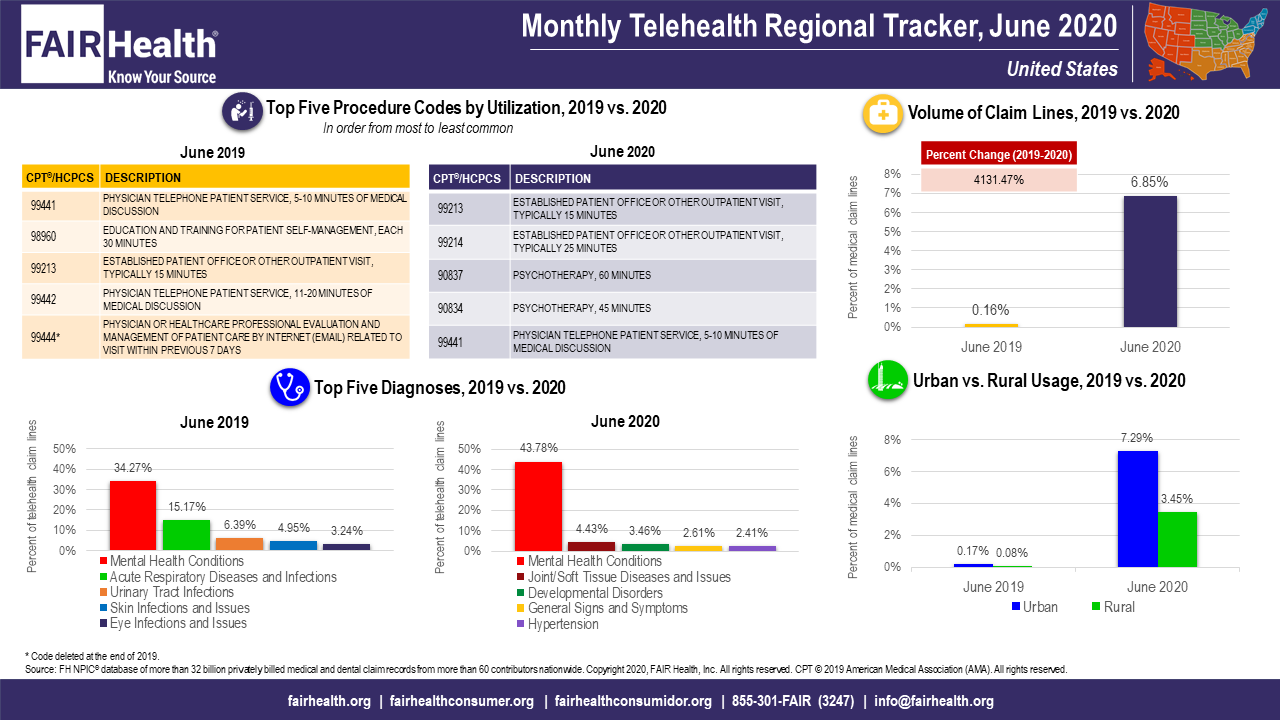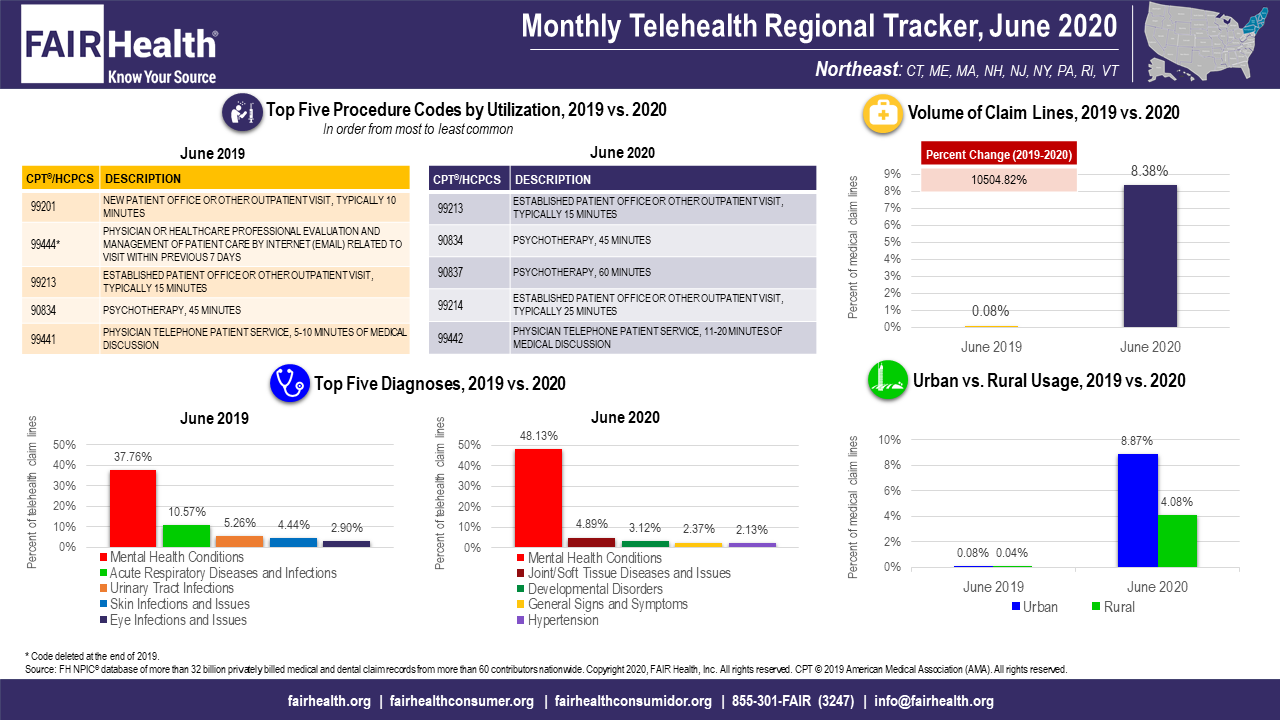Article
Contributor: Telehealth Claim Lines Increased 4132% Nationally From June 2019 to June 2020
Author(s):
Telehealth claim lines increased 4132% nationally from June 2019 to June 2020, rising from 0.16% of medical claim lines in June 2019 to 6.85% in June 2020, according to new data from FAIR Health’s Monthly Telehealth Regional Tracker.
Telehealth claim lines* increased 4132% nationally from June 2019 to June 2020, rising from 0.16% of medical claim lines in June 2019 to 6.85% in June 2020, according to new data from FAIR Health’s Monthly Telehealth Regional Tracker (Exhibit 1). Although considerable, that increase was less than the year-to-year increase the previous month, when telehealth claim lines increased 5680% nationally, from 0.15% of medical claim lines in May 2019 to 8.69% in May 2020. The data represent the privately insured population, excluding Medicare and Medicaid.
Exhibit 1. Monthly Telehealth Regional Tracker, June 2020, United States

(Source: FAIR Health)
While increasing greatly from 2019 to 2020, telehealth claim lines fell 21% nationally on a month-to-month basis, from 8.69% of medical claim lines in May 2020 to 6.85% in June 2020.
Trends in the 4 US census regions (Midwest, Northeast, South, and West) were similar to those in the nation as a whole. In each region, there were large percent increases in volume of claim lines from June 2019 to June 2020, but these increases were smaller than the increases from May 2019 to May 2020. In addition, in each region, there was a drop in the volume of claim lines from May 2020 to June 2020. The biggest drop was in the Northeast (Exhibit 2), where the decrease from May to June was 33%, from 12.5% of medical claim lines to 8.4%.
Exhibit 2. Monthly Telehealth Regional Tracker, June 2020, Northeast

(Source: FAIR Health)
The impact of the coronavirus disease 2019 (COVID-19) pandemic is suggested by the higher telehealth utilization from March to June 2020 in comparison with the same months in 2019. In March and April 2020, many states prohibited in-person rendering of elective procedures and nonemergency medical care, making telehealth an attractive alternative. Many of these prohibitions expired in May as states began to open up, perhaps accounting for the drop in the telehealth share of total medical claim lines in May and June relative to April. However, as the pandemic continued, telehealth usage remained high by comparison with 2019.
Other notable findings of the Monthly Telehealth Regional Tracker concern the top 5 telehealth diagnoses:
- Mental health conditions, already the number one telehealth diagnosis nationally and in every region in May 2020, accounted for an even larger share of telehealth claim lines in June 2020. Nationally, this diagnosis increased from 40% to 44% of telehealth claim lines from May to June 2020. Increases in the Northeast and Midwest were particularly notable, with claims in the Northeast increasing from 41% in May to 48% in June, and in the Midwest from 49% in May to 54% in June.
- Exposure to communicable diseases was the number 5 diagnosis in the South and in the West in June. This diagnosis did not appear among the top 5 diagnoses nationally or regionally in May.
Launched in May as a free service, the Monthly Telehealth Regional Tracker uses FAIR Health data to track how telehealth is evolving from month to month. An interactive map of the 4 US census regions allows the user to view an infographic on telehealth in a specific month in the nation as a whole or in individual regions. In addition to data on the volume of claim lines, diagnoses and urban versus rural usage, each infographic includes findings on the top 5 telehealth procedure codes.
FAIR Health is a national, independent nonprofit organization dedicated to bringing transparency to healthcare costs and health insurance information.
It is clear that the COVID-19 pandemic is having a substantial impact on telehealth. FAIR Health’s Monthly Telehealth Regional Tracker shows the specifics of how this venue of care is being transformed.
*A claim line is an individual service or procedure listed on an insurance claim.
About Robin Gelburd, JD, president of FAIR Health
Robin Gelburd, JD, is the president of FAIR Health, a national, independent nonprofit organization with the mission of bringing transparency to health care costs and health insurance information. FAIR Health possesses the nation’s largest collection of private healthcare claims data, which includes over 32 billion claim records contributed by payers and administrators who insure or process claims for private insurance plans covering more than 150 million individuals. Certified by CMS as a national Qualified Entity, FAIR Health also receives data representing the experience of all individuals enrolled in traditional Medicare Parts A, B and D; FAIR Health includes among the private claims data in its database, data on Medicare Advantage enrollees. Ms Gelburd is a nationally recognized expert on health care policy, data, and transparency.





